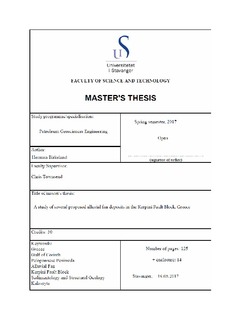A study of several proposed alluvial fan deposits in the Kerpini Fault Block, Greece
Master thesis
Permanent lenke
http://hdl.handle.net/11250/2464504Utgivelsesdato
2017-06-19Metadata
Vis full innførselSamlinger
Sammendrag
The rift in the Gulf of Corinth is one of the most active rifts in the world. Regional N-S extension has caused normal faulting from the Gulf of Corinth and southwards into the Peloponnese Peninsula. The normal faulting resulted in a series of half grabens within a system of uplifted, rotated and north-dipping fault blocks, one of which is the Kerpini Fault Block. Within this southern fault block, many stratigraphic units are deposited in a complex relationship. Three of these units were proposed by Hadland (2016) to be footwall-derived alluvial fan deposits. These units, in addition to a fourth one, was studied in detail during this project. Additionally, a new and updated geological map was constructed. This was done to better understand the layout and extents of the stratigraphic units and faults in the area of study. The fault block mainly consists of pre-fault and syn-fault strata.
Through detailed outcrop analyses and investigation into facies variabilities, the four proposed fans were confirmed to be individual alluvial fan deposits within the Kerpini Fault Block. They were confirmed by classifying the facies into debris-flow, sheetflood and streamflow deposits. Three of the fans were classified as sheetflood-dominated fans, whereas the easternmost fan in the area of study was classified as a debris-flow dominated fan. Only two of the three proposed fans appear to be footwall-derived. The third one was suggested to be sourced from the north, but was in fact sourced from the south. The alluvial fans subject to this study are syn-fault deposits. The pre-fault strata originates from the Kalavryta Fault Block to the south.
Beskrivelse
Master's thesis in Petroleum Geosciences engineering
